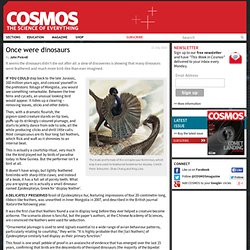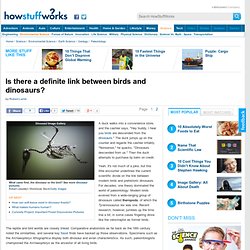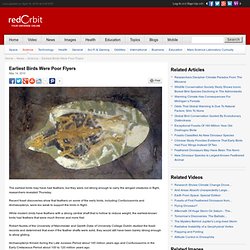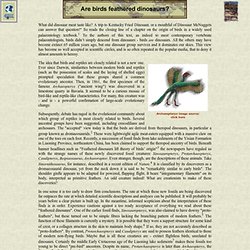

Birds may not have clawed their way up the evolutionary tree (11/17/2007) University of Queensland researchers have clipped the wings of the idea that the ancestors of modern birds were tree dwellers.

Exhaustive work by PhD student Chris Glen and Associate Professor Mike Bennett from UQ's School of Biomedical Sciences, saw them study the claws of thousands of bird feet to come to the conclusion the dinosaur ancestors of modern birds were mostly ground foragers. "This is a really interesting and important piece of the puzzle in terms of the evolution of birds," Mr Glen said. "We have shown that the shape of a bird's claw can clearly indicate whether they are tree dwellers or ground foragers. Mr Glen said though there are some birds that only forage on the ground and those that only forage in trees, there's actually an entire spectrum of birds that do both in differing amounts between these two extremes. Mr Glen said their findings contradicted those arguments. Their research was recently published in the scientific journal Current Biology.
Post Comments: Once were dinosaurs. The male and female of the oviraptosaur Avimimus, which may have used its feathered forelimbs for display.

Credit: Peter Schouten: Zhao Chang and Xing Lida IF YOU COULD step back to the late Jurassic, 160 million years ago, and conceal yourself in the prehistoric foliage of Mongolia, you would see something remarkable. Between the tree ferns and cycads, an unusual looking bird would appear. It tidies up a clearing – removing leaves, sticks and other debris. Then, with a dramatic flourish, the pigeon-sized creature stands on tip toes, puffs-up its strikingly coloured plumage, and starts to jerkily dance from side to side, all the while producing clicks and shrill little calls.
This is actually a courtship ritual, very much like the kind played out by birds of paradise today in New Guinea. It doesn’t have wings, but lightly feathered forelimbs with sharp little claws; and instead of a beak, it has a full set of pointy teeth. “Did they use feathers in complex mating rituals? Is there a definite link between birds and dinosaurs?" A duck walks into a convenience store, and the cashier says, "Hey buddy, I hear you birds are descended from the dinosaurs.

" The duck jumps up on the counter and regards the cashier irritably. "Nonsense," he quacks, "Dinosaurs descended from us. " Then the duck attempts to purchase lip balm on credit. Yeah, it's not much of a joke, but this little encounter underlines the current scientific divide on the link between modern birds and prehistoric dinosaurs. Feathered dinosaur. Fossil of Microraptor gui impressions of feathered wings The realization that the non-avian dinosaurs are closely related to birds raised the possibility of feathered dinosaurs.

Fossils of Archaeopteryx include well-preserved feathers, but it was not until the mid-1990s that clearly non-avialan dinosaur fossils were discovered with preserved feathers. Since then, more than twenty genera of dinosaurs, mostly theropods, have been discovered to have been feathered. Velociraptor. Earliest Birds Were Poor Flyers. May 14, 2010 The earliest birds may have had feathers, but they were not strong enough to carry the winged creatures in flight, researchers revealed Thursday.

Recent fossil discoveries show that feathers on some of the early birds, including Confuciusornis and Archaeopteryx, were too weak to support the birds in flight. While modern birds have feathers with a strong central shaft that is hollow to reduce weight, the earliest-known birds had feathers that were much thinner and more frail. Robert Nudds of the University of Manchester and Gareth Dyke of University College Dublin studied the fossil records and determined that even if the feather shafts were solid, they would still have been barely strong enough to allow gliding. Archaeopteryx thrived during the Late Jurassic Period about 145 million years ago and Confuciusornis in the Early Cretaceous Period about 100 to 120 million years ago.
Archaeopteryx is believed to be an intermediary form between reptiles and birds. When feathered dinosaurs ruled the Earth - Image 1. Are birds feathered dinosaurs? What did dinosaur meat taste like?

A trip to Kentucky Fried Dinosaur, or a mouthful of Dinosaur McNuggets can answer that question! " So reads the closing line of a chapter on the origin of birds in a widely used palaeontology textbook.1 To the authors of this text, as indeed to most contemporary vertebrate palaeontologists, birds didn’t simply descend from dinosaurs - birds are dinosaurs. All the others may have become extinct 65 million years ago, but one dinosaur group survives and it dominates our skies. This view has become so well accepted in scientific circles, and is so often repeated in the popular media, that to deny it almost amounts to heresy.
The idea that birds and reptiles are closely related is not a new one. Subsequently, debate has raged in the evolutionist community about which group of reptiles is most closely related to birds. In one sense it is too early to draw firm conclusions. Paul Garner (December 1999) References Fastovsky D.E. and Weishampel D.B. Feathered dinosaur nicknamed "Dave" Anchiornis huxleyi feathers - scientists complete color palette of a dinosaur for first time. Deciphering microscopic clues hidden within fossils, scientists have uncovered the vibrant colors that adorned a feathered dinosaur extinct for 150 million years, a Yale University-led research team reports online Feb. 4 in the journal Science.

Unlike recently published work from China that inferred the existence of two types of melanin pigments in various species of feathered dinosaurs, the new study analyzed color-imparting structures called melanosomes from an entire fossil of a single animal, a feat which enabled researchers to reveal rich color patterns of the entire animal. In fact, the analysis of melanosomes conducted by Yale team was so precise that the team was able to assign colors to individual feathers of Anchiornis huxleyi, a four-winged troodontid dinosaur that lived during the late Jurassic period in China. "This was no crow or sparrow, but a creature with a very notable plumage," said Richard O. Oldest Feathered Dino Found in China - Dinosaur is earliest known feathered species, may have flown on four wings. Origin of birds. Feathered dinosaurs - Citizendia.